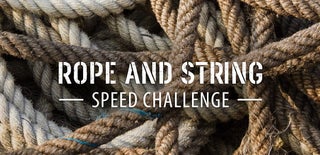Introduction: Knitting Compostable Eco-Stools
For the rope challenge I wanted to make something which is typically strong only in tension (rope) handle a compressive force (someone sitting on it). I also have been wanting to experiment with using natural fibers with hide glue to make a rigid, nontoxic, compostable solid.
Supplies
cotton macrame cord 5mm diameter for knitting
hot hide glue (animal glue) aka industrial gelatin for soaking the knitted piece
stencil paper or poster board for making a mold
mold release: soap, cooking spray or car wax so it doesn’t stick to the mold
Tools: A round knitting loom to knit the rope on. (mine is 20” diameter with 16 pegs) These are easy to make with scraps and dowels
Fan for drying
Step 1: Gather Supplies
The loom is easy to make. Make it bigger around than the finished knitting you want. Mine is 20 inches across with 16 pegs. More pegs will result in a tighter knit (smaller holes). I wanted it to be open and net-like.
Step 2: Casting On
A round loom knits a tube. I used a drawstring cast-on so I could close one end where the seat will be. To do this, tie the end of the rope to the starting peg, and moving to the right weave in and out of every other peg as shown. Then go around again only this time on the outside of all the pegs. Then knit off the first pass over the second pass as shown. Since the first pass was outside on every other peg, those are the only ones to knit off.
Step 3: Knitting
Now on to the normal knitting. Go completely around each peg, then knit off as shown lifting the bottom loop over the top loop. Repeat as many times as you need to depending on how high you want the stool to be. I did 19 rows for a 16” stool.
Step 4: Drawing In
After a few rows you can start drawing in the bottom. To do this, untie the starting end from the starting peg and pull gently downward. You’ll see the opening of the circle get smaller. You can do this after every row until it’s closed completely. Then tie off with an overhand knot and cut off the extra rope. Keep knitting until you have a big enough web for the form to fit inside.
Step 5: Casting Off
To finish, cut the cord with about 5 feet extra and feed it through each loop in turn as you take them off the pegs. Then finish with an overhand knot and trim off any extra.
Step 6: The Form
For the first one I cut the width of the paper to the height of the stool (16”). Then rolled it into a tube 10” in diameter and stapled it. I didn’t use mold release since I was using stencil board and usually nothing sticks to it, but it did stick at the top and was hard to get out of the finished stool. So I do recommend using something to keep the rope from sticking to the form. Soap, wax, grease…something. The paperboard was not ideal. For the second one I built a more robust form and sprayed it with car wax. Since the knit pulls in as it goes down, I made sure I would be able to get the pieces out after the glue set. The white round plastic disk will be broken to get it out at the end.
Step 7: Knit Another (optional)
I bought cord in black and white and wanted to try both. The video is a quick step by step of the white, and a fast time lapse of the black. In real time the black took about an hour to knit.
Step 8: Mix the Glue
Hot hide glue comes in a dry granulated form. You mix it with water in a 1:1 ratio by weight. I used a pound of glue, and a pint of hot water. Then you heat it slowly to 145 degrees F. This is done in a double boiler so it doesn’t burn or overheat which weakens the glue. I used a cheap hot pot with a temperature control with some water in it and a steel mixing bowl that fit it nicely with the glue mixture in it. At 145 F. it’s ready to use. I kept it on the heat while soaking the knitted rope.
Step 9: Soak the Knitting
Put the rope into the pot with the glue. I did this by holding it at the top and slowly lowering it into the glue. It needs a little time and squeezing to get the glue to soak into the fibers.
Step 10: Hang the Knitting on the Form
Hot hide glue starts to gel as it cools so you have to work fast. I pulled it out and draped it over the paper form. This was awkward and the paper caved in a little near the top. Not ideal. Then I adjusted where the weave met the floor, and let it sit overnight. The top was drooping down a little so I wove some ¼” sticks through to level it better. The second form worked much better.
Step 11: Remove the Form
The next day when the glue was dry I removed the form. This wasn’t easy. Use mold release! The second worked better.
Step 12: Enjoy
If they ever break they can go in the compost. All natural cotton and gelatin.

First Prize in the
Rope & String Speed Challenge











